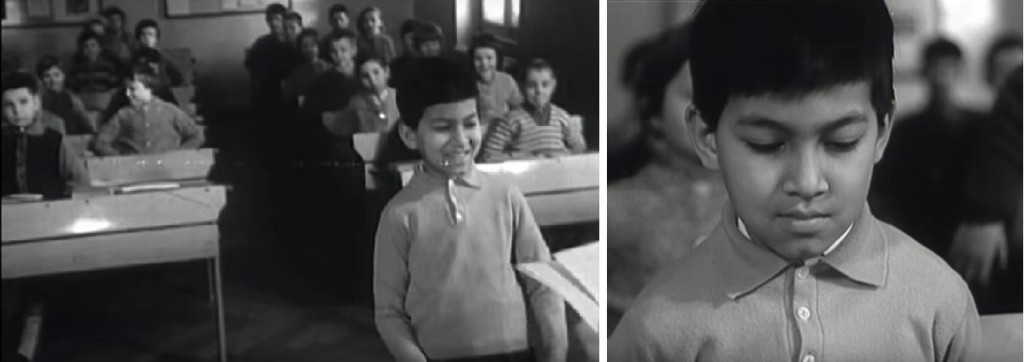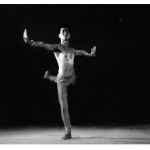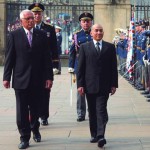Links between Prague and Phnom Penh, through wars and music and art, in the life of Norodom Sihamoni, the sovereign dancer who speaks Czech
It was May 1962, when Norodom Sihanouk, at the time the Cambodian King, addressed a letter for a personal, family deal to Czechoslovak President Antonín Novotný, and Prime Minister Viliam Široký: “Considering the friendly relations and cooperation between our two countries, I kindly ask the government of the Czechoslovak Socialist Republic to take care of the education of my nine year old son, Norodom Sihamoni”.
It was a time where, in the name of communist ideology with an international vocation, tropical Asia and Central Europe were not so far apart. Consequently, the “little prince”, the first-born child of the “father prince” Sihanouk, regarded by Cambodians as a demigod, and the sixth and last Queen Norodom Monineath, moved from the sinuous royal palace in Phnom Penh to a Prague elementary school. For Norodom Sihamoni a new life began in the Czechoslovak capital. The choice of Prague responded precisely to the will of the Khmer head of state, and his wife Monineath, who had Cambodian and French blood in her veins. The two immediately realized that their son had inherited not only the combination of the first two syllables of their names, Siha-Moni, but also a particular vocation for the arts and literature. Moreover, Sihanouk was in turn also an author of music, prose and a film director, the young Sihamoni himself appeared as the protagonist in one of his father’s films, “The Little Prince” in 1967. For this reason Czechoslovakia had so much of the promised land to grow and develop these talents: “My wife and I feel that our child has a special interest in the arts. I would like his education to be centered on the study and practice of music and ballet. This way one day he will be able to integrate these Western-style art forms into the cultural development of his country. I am convinced that Czechoslovakia, whose worldwide reputation in music is known to all, is the ideal place to start it in these disciplines”.
 For the Czechoslovak Government it was an honour to welcome the Cambodian Prince who joined the national education in third grade, in September 1962. And from those days, more than half a century later, there are still some precious images remaining: black and white footage from Czechoslovak television, showing Sihamoni in a primary school classroom in the diplomatic district of Bubeneč, sitting amongst his classmates. When asked by his teacher he reads a text in Czech, smiles, then approaches her desk to pick up his report card.
For the Czechoslovak Government it was an honour to welcome the Cambodian Prince who joined the national education in third grade, in September 1962. And from those days, more than half a century later, there are still some precious images remaining: black and white footage from Czechoslovak television, showing Sihamoni in a primary school classroom in the diplomatic district of Bubeneč, sitting amongst his classmates. When asked by his teacher he reads a text in Czech, smiles, then approaches her desk to pick up his report card.
For Sihamoni, it was the beginning of a long stay and rich artistic training: the then Prince, who since has ascended to the throne of the new Cambodian monarchy following his father Sihanouk’s death in 2004, (and who since 1993 had become King again) found fertile ground in Prague’s cultural riches to cultivate his interests and develop his skills. The man as he is today, once an artist, and once a diplomat, was a delegate of Cambodia at UNESCO in the ‘90s, and finally King, formed himself in the academies, theatres and streets of the Czechoslovak capital of the ‘60s and ‘70s.
He would remain in Prague for more than ten years, completing high school and later graduating from the Conservatory where he attended courses in music, theatre, and dance, his greatest passion, eventually being awarded, in 1971, as the best student of classical dance class at the Conservatory.
The insight that had prompted his father to send him to Czechoslovakia was spot on: while not particularly inclined to the study of mathematics and sciences, Prince Sihamoni was a true lover of the stage. He loved literature and opera, and did everything to follow the Prague cultural events, for example for the ballet “The Nutcracker”.
He knew the actors of the capital, the artistic circles, and participated willingly in the intellectual salons of the city and in music nights. For years, these would create a strong bond between him, and the capital and Czech culture, however Sihamoni remained a member of the Cambodian royal family, and therefore it would be the contemporary history of his country that brought him back.
From the Civil War to the throne of Cambodia
Following the coup d’etat of Lon Nol in March 1970, an order prohibited the return of all the royal family to Cambodia. The Cambodian ambassador to Prague was forced to ask the prince to abandon his embassy accommodation, so Sihamoni decided to move in with the family of his elementary school teacher with whom he had maintained a friendly relationship. Unable to return home, he would stay in the Czech capital until 1975 when he joined his father in North Korea, where he would continue his studies at the National Academy of Cinematography in Pyongyang.
After being called home in the wake of the Khmer Rouge victory in the civil war, he discovered that the new regime that his family had helped to rise to power soon turned against them. From the summer of 1976, he was held under house arrest for three years, together with his younger brother, and their parents in the royal palace in Phnom Penh, while Cambodia was sinking into the hell of Pol Pot.
Only in 1979, with the progress of the Vietnamese fighting against the Khmer dictatorship, he was able to leave the country and reach China, leaving a country at war behind him again. The road of the arts, outlined during his Czech years, would take him later to the inevitable Mecca of European artists: Paris. There, Sihamoni would remain for more than twenty years working as a teacher of classical ballet in the conservatories of Marius Petipa, Gabriel Faure and W.A. Mozart. Also in the French capital, he formed his own group of dancers, known as Ballet Deva, with whom he also directed two dance films: Dream and Four Elements. In 2004 the artist Prince, who had grown up in Prague, Paris and Phnom Penh, appeared to be almost forced to take the place of his father Norodom Sihanouk on the throne of his native country, which in the meantime became a monarchy again. But his Czechoslovak adolescence remained inside, and unsurprisingly he came back several times, this time as King, in what was by then the Czech Republic. First in 2006 to receive honorary citizenship of Prague, then later in 2010 when he was awarded a doctorate ad honoris causa from the Academy of Arts. Even after more than thirty years, when he took the floor to thank the University deans, the sovereign spoke Czech without faltering.
The new crown for the king
However, an even more recent anecdote led to more talk of him in the capital: when the designer Viktorie Beldová, created a crown for Sihamoni, “the only sovereign in the world to speak Czech fluently”.
Beldová among other things is part of the prestigious family of Belda jewelers, who for decades has taken care of the St. Wenceslas crown.
It must be said then that as a result of the civil war in Cambodia, the jewelry destined for the coronation of the King has got completely lost.
It is once again that art, therefore has brought Bohemia and Cambodia closer together. Viktorie created her crown in gold and silver, inspired by Cambodian archeology, and Buddhist symbolism such as the Bodhi tree, under which Buddha reached enlightenment.
The creation of this crown and the entire collection of royal jewels, has led to an outpour of ink, attracting a large number of visitors to the Kvalitář gallery in Prague (Senovážné náměstí 17), where the precious collection will be on display until February 6.
Although the designer explains that due to the Cambodian royal protocol is not easy to propose a crown to a foreign monarch, it is possible to think that one day, who knows, the little prince who came from the East will wear a crown forged for him on his head, in his adopted city.
by Edoardo Malvenuti








